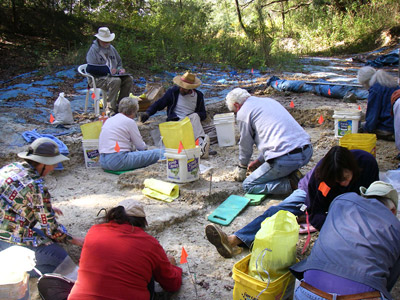Thomas Farm
University of Florida Vertebrate Fossil Locality GI001
Location
About 8 miles north-northeast of Bell, Gilchrist County, Florida; 29.86° N, 82.83° W.
Age
- Early Miocene Epoch; early Hemingfordian land mammal age
- About 18 million years old
Basis of Age
Biochronology (an early Hemingfordian age is indicated by the combined presence of the bear Phoberocyon, the mustelid Leptarctus, the rhino Floridaceras, and the canid Metatomarctus).
Geology
Fossils are found in alternating beds of clay and calcareous sand, with occasional lenses or beds of limestone boulders.
Depositional Environment
Ancient sinkhole with an associated cave system.
Fossils
New species continue to be found and described. Discovery and excavation of important specimens of rare taxa also occur frequently.
Excavation History and Methods

The site was discovered by Clarence Simpson of the Florida Geological Survey in 1931, who found fossils on the spoil pile of a well dug by Raeford Thomas. Florida Geological Survey crews excavated at the site until January 1932. The recovered specimens were sent to George G. Simpson, then of the American Museum of Natural History, who recognized their significance and quickly published the first scientific paper on the site in 1932. Thomas Barbour of Harvard University purchased the site and the surrounding 40 acres in the late 1930s and deeded it to the University of Florida, with the provision that field crews from Harvard’s Museum of Comparative Zoology could collect at the fossil site. Museum of Comparative Zoology field crews led by Ted White conducted the first large scale excavations at Thomas Farm, and these continued until the early 1950s. Then the site was worked cooperatively until about 1960 by the University of Florida (by Walter Auffenberg, Pierce Brodkorb, and Robert Bader of the Department of Biology; specimens curated in the Florida Museum of Natural History collection) and the Florida Geological Survey (led by the newly hired Stanley Olsen, who had previously worked at the site for Harvard). Auffenberg and Brodkorb were the first to intensively use screenwashing at this site, which proved to have a remarkably rich small vertebrate fauna. Between 1960 and 1980, the site was worked infrequently by the Florida Museum of Natural History, as other major Florida fossil sites, such as Inglis 1A, Love Bone Bed, McGehee Farm, Withlacoochee River 4A, and others were discovered and worked by museum crews.
The next major phase of excavation began in 1981, with field work led by then UF graduate student Ann Pratt. Pratt and co-workers established a permanent grid system and were the first to measure detailed locations and orientations for bones in the site (Pratt, 1990). Many tons of sediment from the site were screenwashed to recover small vertebrate fossils and screens with smaller size mesh than before were used, resulting in recovery of even smaller specimens. Annual field work at Thomas Farm continued through 2016, with at least one field season per year. Dr. Jonathan Bloch of the Florida Museum of Natural History is the person currently in charge of collecting at Thomas Farm. Despite over 75 years of excavations and recovery of tens of thousands of fossils, a large volume of sediment remains to be dug. Current excavation practice is to work in 1 meter by 1 meter areas (within the grid system established in 1981) and at depth intervals of 10 centimeters. All matrix is saved and wet screened, either on site, or at the FLMNH.
New species continue to be found and described from Thomas Farm on a regular basis (e.g., Morgan and Czaplewski, 2003; Labs Hochstein, 2007; Steadman, 2008; Beatty, 2010). Discovery and excavation of important specimens of rare taxa also occur frequently. For example, relatively complete skulls of Amphicyon longiramus and Alligator olseni were found during the Fall 2009 dig.
Videos
Discussion
By almost any measure, Thomas Farm is the single most important vertebrate fossil site in Florida, and a good case could be made that it is the most important vertebrate fossil site of Cenozoic age from the eastern United States. At the time of its discovery, very little was known of early Miocene terrestrial faunas in eastern North America. Thomas Farm has extremely large samples of both small and large vertebrates, including types of animals that are often rare elsewhere, such as birds, carnivores, and bats. Except for fish, all other types of vertebrates are well represented. Many dozens of new species have been named based on specimens from Thomas Farm. Thomas Farm and the surrounding property is owned by the University of Florida and no access or digging is allowed except as part of organized excavations lead by Florida Museum paleontologists.
Sources
- Author: Richard C. Hulbert Jr.
- Original date: January 30, 2009
- Last edited: Richard C. Hulbert Jr.
- Last updated: February17, 2022
This material is based upon work supported by the National Science Foundation under Grant Number CSBR 1203222, Jonathan Bloch, Principal Investigator. Any opinions, findings, and conclusions or recommendations expressed in this material are those of the author(s) and do not necessarily reflect the views of the National Science Foundation.
Copyright © Florida Museum of Natural History, University of Florida